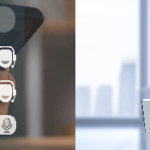Without exception, we all hate the maddening menus and mind-numbing muzak we suffer through while waiting for an actual human being to answer a customer service line.
Hopefully, salvation is around the corner.
Tenyx, a trailblazer in voice AI systems, has unveiled a comprehensive conversational AI solution that is poised to redefine how enterprises interact with their customers.
No, it’s not a call center in India or the Philippines. Yes, it uses AI-generated voices. But, according to Tenyx, it can understand what you say no matter how much you mutter – and answer clearly and cogently.
Led by Itamar Arel, a seasoned entrepreneur and former academic, Tenyx has emerged from the shadows of its previous success story, Apprente, which was acquired by McDonald’s in 2019 and later by IBM in 2021. Building on the lessons learned from co-founding Apprente, Arel and his team have crafted a voice AI solution that is as innovative as it is ambitious.
“We’re proud to unveil a voice solution that not only meets but exceeds the expectations of businesses in their customer interactions,” Arel said during a telephone interview.
At the heart of Tenyx Voice lies a deep understanding of the challenges plaguing existing voice AI systems, from user frustration and limited analytics to rising costs and scaling difficulties. Tenyx leverages recent advancements in large language models (LLMs), automatic speech recognition (ASR), and text-to-speech (TTS) technologies to create a natural and engaging conversation flow that feels remarkably human.
Bid Farewell To Maddening Menus And Mind-Numbing Muzak, And Embrace A New Era Of Intuitive AI-Powered Customer Support
By optimizing voice dynamics, such as end-point prediction, handling interruptions, and dealing with acoustic distortions, Tenyx Voice knows when you’re pausing to think or look for information as opposed to waiting for an answer. It draws on a company-specific knowledge base to give the correct information at the right time.
By carefully fine-tuning its AI models for each industry, Tenyx ensures that its voice AI agents are well-versed in the specific terminologies and conversation dynamics of the domain they serve. This bespoke approach sets Tenyx Voice apart from its competitors, who often rely on one-size-fits-all solutions that fail to capture the subtleties of different domains.
To achieve this level of customization without compromising the integrity of the underlying model, Tenyx has developed a groundbreaking approach to fine-tuning LLMs that mitigates the risk of catastrophic forgetting – the phenomenon of overwriting previous knowledge during the fine-tuning process. Their novel technique ensures that the model retains its knowledge, reasoning capabilities, and safety measures, even as it adapts to new domains.
David Teng, CEO at RealtyTrac, one of the first customers to deploy Tenyx Voice, says “our partnership with Tenyx empowers us to deliver a unique and differentiated customer experience that represents our brands and helps us deliver on our revenue and efficiency goals.”
In the 1950s and 1960s, company call centers emerged, using Private Automated Business Exchanges (PABX) instead of switchboard operators to connect customer calls to service agents. But as call volume increased, hold times got longer.
By the 1970s, Automatic Call Distributor (ACD) systems automatically routed calls to available agents, but call volume increased further and soon there weren’t enough agents.
Interactive Voice Response (IVR) systems were introduced in the 1980s, allowing callers to interact with computerized voice menus using touch-tone phones and, by the 1990s, by using their voice. IVR systems reduced the number of calls that needed a human to answer.
But as the internet brought down the cost of phone calls, call centers sprang up in countries where labor was cheap – so if you did need to speak to a human, you ended up talking to someone on the other side of the globe. Meanwhile, IVR menus got longer. Pretty soon, we were tearing the collective hair out of our heads.
Cision, the public relations company, found that a third of people polled hang up rather than wait on customer service calls and another study from Velaro found that a staggering 59% of customers hang up after being placed on hold for a minute or less. Meanwhile, a study conducted by custom market research firm Harris Interactive found that 89 percent of U.S. adults who stopped doing business with an organization due to a poor customer experience began doing business with a competitor.
By offering enterprises access to cutting-edge conversational voice agents that understand the way people talk, Tenyx is hoping to save businesses millions. Tenyx has demonstrated their LLM prowess with their open-source model, Tenyx_Chat-7B-v1, which has claimed a top spot on Hugging Face’s MT-Bench Leaderboard, a benchmark and evaluation platform for assessing the multi-turn conversational capabilities of LLMs. The model outperformed even larger models like ChatGPT.
Itamar Arel, cofounder of Tenyx
Tenyx
Tenyx founder Arel said Tenyx_Chat-7B-v1 model is one of multiple AI models that allow the company to optimize for customer needs without risking things like forgetting effects.
Tenyx’s voice agents are designed to continuously learn and adapt to customer questions on the fly, ensuring that enterprises can provide accurate and personalized support. These AI-powered agents are also engineered to avoid harmful outputs, such as biased or toxic language.
But the potential impact of Tenyx Voice extends far beyond cost savings and operational efficiencies. By enabling enterprises to deliver a superior customer experience, the solution has the potential to enhance their brands and foster long-lasting customer loyalty.
Hopefully, we can soon bid farewell to the frustrations of the past and embrace a new era of intuitive conversational AI.
This post was originally published on 3rd party site mentioned in the title of this site
